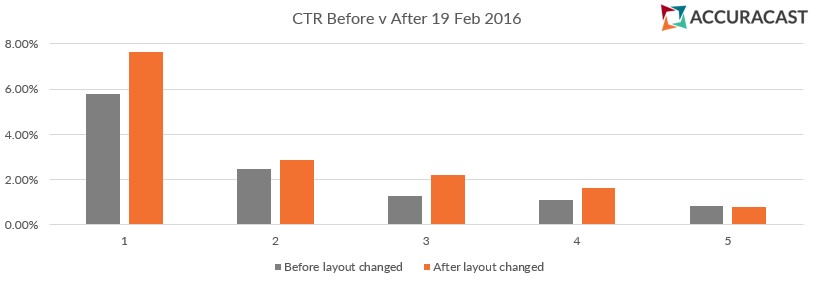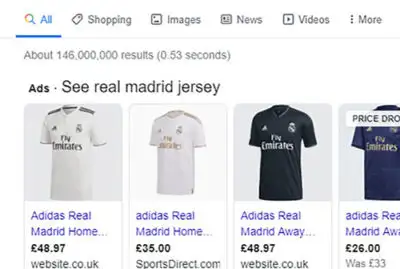It’s been more than a year since Google stopped showing ads on the right-hand side of desktop search results, and added a fourth row of ads above the organic search results. Initial results showed that users were clicking more on all but one of the top four ad positions. We examined year-on-year data to check whether this remained true over the long term, to determine whether Google’s gamble paid off.
The table below shows click-through rates on computers only (excluding mobile and handheld devices) during the 12-month period before and after the change in ad placements on Google desktop search results:
| Position | Old click-through rate |
New click-through rate |
Change in CTR |
|---|---|---|---|
| 1 | 5.77% | 7.65% | 32.56% |
| 2 | 2.48% | 2.84% | 14.79% |
| 3 | 1.28% | 2.20% | 72.44% |
| 4 | 1.08% | 1.64% | 51.85% |
| 5 | 0.84% | 0.78% | -7.56% |
Comparing click-through rates for each position before and after the change, we can see that click-through rates have increased for all positions above the organic search results, with positions 3 and 4 seeing the largest gains.

Interestingly, ads in position 5 saw a slight drop in CTR after the change. The fall in CTR is surprisingly minor, especially considering that ads in position 5 are now located far below the fold, under the organic search results.
Across the board, CTRs for ads in the top 4 positions, above the organic search results, have increased by 49.04% year-on-year.
Google’s gamble has definitely paid off! If you consider this in monetary terms, it represents a huge jump in profitability from search advertising. Moreover, most regular users either didn’t notice the change or didn’t mind it, and they continue using Google to search more and more every month.
Data for this study is based on 2 million searches in each 12-month period before and after Google dropped the right-column ads. Data has been collected across a random set of accounts that have been maintained in a relatively consistent manner over the entire 24-month period. The same metrics were also measured for a control group of ads that maintained the same positions before and after the change to verify relative consistency in the results, keeping in mind that expanded ads were also rolled out on Google search in July 2016, and this new format impacted CTR further.










